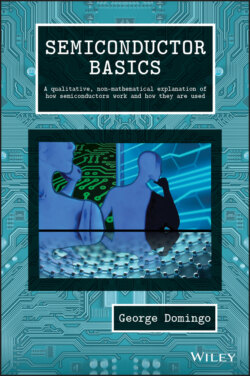Читать книгу Semiconductor Basics - George Domingo - Страница 2
Table of Contents
Оглавление1 Cover
2 Acknowledgements
3 Introduction
4 1 The Bohr Atom 1.1 Sinusoidal Waves 1.2 The Case of the Missing Lines 1.3 The Strange Behavior of Spectra from Gases and Metals 1.4 The Classifications of Basic Elements 1.5 The Hydrogen Spectrum Lines 1.6 Light is a Particle 1.7 The Atom's Structure 1.8 The Bohr Atom 1.9 Summary and Conclusions Appendix 1.1 Some Details of the Bohr Model Appendix 1.2 Semiconductor Materials Appendix 1.3 Calculating the Rydberg Constant
5 2 Energy Bands 2.1 Bringing Atoms Together 2.2 The Insulator 2.3 The Conductor 2.4 The Semiconductor 2.5 Digression: Water Analogy 2.6 The Mobility of Charges 2.7 Summary and Conclusions Appendix 2.1 Energy Gap in Semiconductors Appendix 2.2 Number of Electrons and the Fermi Function
6 3 Types of Semiconductors 3.1 Semiconductor Materials 3.2 Short Summary of Semiconductor Materials 3.3 Intrinsic Semiconductors 3.4 Doped Semiconductors: n‐Type 3.5 Doped Semiconductors: p‐Type 3.6 Additional Considerations 3.7 Summary and Conclusions Appendix 3.1 The Fermi Levels in Doped Semiconductors Appendix 3.2 Why All Donor Electrons go to the Conduction Band
7 4 Infrared Detectors 4.1 What is Infrared Radiation? 4.2 What Our Eyes Can See 4.3 Infrared Applications 4.4 Types of Infrared Radiation 4.5 Extrinsic Silicon Infrared Detectors 4.6 Intrinsic Infrared Detectors 4.7 Summary and Conclusions Appendix 4.1 Light Diffraction Appendix 4.2 Blackbody Radiation
8 5 The pn‐Junction 5.1 The pn‐Junction 5.2 The Semiconductor Diode 5.3 The Schottky Diode 5.4 The Zener or Tunnel Diode 5.5 Summary and Conclusions Appendix 5.1 Fermi Levels of a pn‐Junction Appendix 5.2 Diffusion and Drift Currents Appendix 5.3 The Thickness of the Transition Region Appendix 5.4 Work Function and the Schottky Diode
9 6 Other Electrical Components 6.1 Voltage and Current 6.2 Resistance 6.3 The Capacitor 6.4 The Inductor 6.5 Sinusoidal Voltage 6.6 Inductor Applications 6.7 Summary and Conclusions Appendix 6.1 Impedance and Phase Changes
10 7 Diode Applications 7.1 Solar Cells 7.2 Rectifiers 7.3 Current Protection Circuit 7.4 Clamping Circuit 7.5 Voltage Clipper 7.6 Half‐wave Voltage Doubler 7.7 Solar Cells Bypass Diodes 7.8 Applications of Schottky Diodes 7.9 Applications of Zener Diodes 7.10 Summary and Conclusions Appendix 7.1 Calculation of the Current Through an RC Circuit
11 8 Transistors 8.1 The Concept of the Transistor 8.2 The Bipolar Junction Transistor 8.3 The Junction Field‐effect Transistor 8.4 The Metal Oxide Semiconductor FET 8.5 Summary and Conclusions Appendix 8.1 Punch Trough
12 9 Transistor Biasing Circuits 9.1 Introduction 9.2 Emitter Feedback Bias 9.3 Sinusoidal Operation of a Transistor with Emitter Bias 9.4 The Fixed Bias Circuit 9.5 The Collector Feedback Bias Circuit 9.6 Power Considerations 9.7 Multistage Transistor Amplifiers 9.8 Operational Amplifiers 9.9 The Ideal OpAmp 9.10 Summary and Conclusions Appendix 9.1 Derivation of the Stability of the Collector Feedback Circuit
13 10 Integrated Circuit Fabrication 10.1 The Basic Material 10.2 The Boule 10.3 Wafers and Epitaxial Growth 10.4 Photolithography 10.5 The Fabrication of a pnp Transistor on a Silicon Wafer 10.6 A Digression on Doping 10.7 Resume the Transistor Processing 10.8 Fabrication of Other Components 10.9 Testing and Packaging 10.10 Clean Rooms 10.11 Additional Thoughts About Processing 10.12 Summary and Conclusions Appendix 10.1 Miller Indices in the Diamond Structure
14 11 Logic Circuits 11.1 Boolean Algebra 11.2 Logic Symbols and Relay Circuits 11.3 The Electronics Inside the Symbols 11.4 The Inverter or NOT Circuit 11.5 The NOR Circuit 11.6 The NAND Circuit 11.7 The XNOR or Exclusive NOR 11.8 The Half Adder 11.9 The Full Adder 11.10 Adding More than Two Digital Numbers 11.11 The Subtractor 11.12 Digression: Flip‐flops, Latches, and Shifters 11.13 Multiplication and Division of Binary Numbers 11.14 Additional Comments: Speed and Power 11.15 Summary and Conclusions Appendix 11.1 Algebraic Formulation of Logic Modules Appendix 11.2 Detailed Analysis of the Full Adder Appendix 11.3 Complementary Numbers Appendix 11.4 Dividing Digital Numbers Appendix 11.5 The Author’s Symbolic Logic Machine Using Relays
15 12 VLSI Components 12.1 Multiplexers 12.2 Demultiplexers 12.3 Registers 12.4 Timing and Waveforms 12.5 Memories 12.6 Gate Arrays 12.7 Summary and Conclusions Appendix 12.1 A NAND implementation of a 2 to 1 MUX
16 13 Optoelectronics 13.1 Photoconductors 13.2 PIN Diodes 13.3 LASERs 13.4 Light‐emitting Diodes 13.5 Summary and Conclusions Appendix 13.1 The Detector Readout
17 14 Microprocessors and Modern Electronics 14.1 The Computer 14.2 Microcontrollers 14.3 Liquid Crystal Displays 14.4 Summary and Conclusions Appendix 14.1 Keyboard Codes
18 15 The Future 15.1 The Past 15.2 Problems with Silicon‐based Technology 15.3 New Technologies 15.4 Silicon Technology Innovations 15.5 Summary and Conclusions
19 Epilogue
20 Appendix A: Useful Constants A.1 Fundamental Physical Constants A.2 Basic Units A.3 Derived Units
21 Appendix B: Properties of Silicon
22 Appendix C: List of Acronyms
23 Additional Reading and Sources
24 Index
25 End User License Agreement
